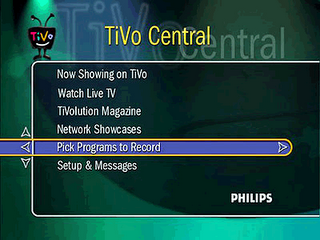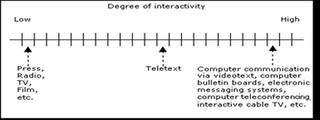Well, it's election night in the U.S. and I was searching the blogs which, I had read earlier, were going to start posting exit polls now (5 PM EST). Somehow I found myself going to MSNBC online and, after a brief (15 second) spot for something medical (not a great ad apparently), a relatively flawless video picture and (importantly) audio showed up in a 430 by 240 window (granted, TV engineers woould find it simply horrid but you have to know TV engineers to understand this statement). I could watch in full screen, but that did show artifacts. I could have continued to watch that fullscreen (it wasn't that bad), but there was no need as my eyes are maybe 15 inches from the screen.
This is an old (4-year-old) laptop running Windows 2000, and the video is fine. MSNBC online also has video clips, basically news stories that I can click on an watch at any time. One very interesting note is that when MSNBC went to the commercial break, it played looped music of the MSNBC election theme music and an animated image saying MSNBC's Live Coverage Will Resume Shortly" along with their animated graphic (Decision 2006) and a reference to a politics web site that I did not get down quickly enough. I like Chris Mathews (who doesn't?), but I am hoping to check other news sites right now.... cbsnews.com and it almost 6 PM EST.
cbsnews.com's page is very busy with many screen shots of individual stories but I don't see anything that looks like a link to live video other than one for the CBS Evening News that is not on air, I assume, right now. I clicked on the link to CBS Evening News and was asked to login. I did not do that on MSNBC, but it's possible that I have login information stored in a cookie for MSNBC.
On to abcnews.com at 6 PM EST...The abcnews.com site looks far different from the cbsnews.com site. In fact, it looks somewhat archaic and over-simplified compared to the flashy, busy cbsnews.com home page. News of Britney Spears' divorce is part of a slideshow of news stories I could choose. There are a massive number of stories listed by title, so many that it looks like the bibliography in the back of a book. I hate to do this because I am enjoying the MSNBC audio (it's still running in a different window) but abcnews.com has a podcast of "lawyers on stand-by" for voting problems (sponsored by AT&T). The podcast has a music bed and a report of about 60 seconds from Brian Ross, ABC News' investigative reporter. Under a text banner saying "Breaking News" ABC cites an exit poll showing "FIRST PRELIMINARY EXIT POLL RESULTS: NEARLY 6 IN 10 VOTERS DISAPPROVE OF THE WAR IN IRAQ AND THE WAY BUSH IS HANDLING HIS JOB" (sorry, cut and paste job and I don't want to clean it up right now).
So far, only MSNBC has impressed me, so let's switch to the other cable news networks starting with Foxnews.com. It is now about 6:15 PM EDT. The foxnews.comhome page is very different fromthe others. It is clean with only a relatively few headlines. I see a link to Brit Hume at 7 PM but so far do not see a link for live video at the moment...still looking. I see as soon as I scroll down that the site looks more like cbsnews.com with lots of individual stories and "celebrity" foxnews.com reporters (including Alan Colmes). I see there is a headline saying "Americans voting to decide which party controls Congress; widespread polling complaints; FBI probes claims in Virginia." abcnews.com used the word "sporadic." Chris Mathews reported that a liberal organization was offering a $250,000 reward for information about any voter intimidation taking place across the country. What must the rest of the world think?
I have to fly now to cnn.com which, like foxnews.com, has a simple "above the fold" appearance with a picture of three voting booths and a small graphic showing the Senate as currently configured (yes, blue and red seats in a barf chart) and an ad on the upper right portion of the screen. In looking for a live feed I see that I am asked to join CNN's pipeline for $2.95/month or "Save 20%" if I order the entire year. They appear to be charging for what msnbc.com is giving free. The rest of the site is like a smaller version of the very littered abcnews.com site with cnn.com showing far fewer links. I'm surprised unless I am missing something here.
I now will got to news.google.com just out of curiosity and the second story listed is, again, Britney Spears and the top headline is "
Tight legislative races could bring new faces to Salem" as in Oregon. I'd love to have a google employee explain how that's their "top" story (again, it could be tied to my searching habits on google, I just don't know). I clicked on the U.S. tab on the left under Top Stories and here it is:
Highlights from national exit poll in US midterm electionsInternational Herald Tribune - 30 minutes ago. So this story was posted apparently at about 6 PM EST. "The survey was conducted for The Associated Press and television networks by Edison Media Research/Mitofsky International among 8,344 voters nationwide, most of them as they left 250 randomly selected precincts Tuesday. The sample included 1,500 absentee or early voters interviewed by telephone during the past week in 10 states with heavy early voting. Margin of sampling error plus or minus 2 percentage points for the overall sample, larger for subgroups." What strikes me is the condemnation of the way things are going in Iraq, 8 in 10 respondents said the economy was "very important." This rendition does tie the issues to how the respondents voted.
It is now about 6:30 PM EST and cbsnews.com's link to the broadcast of The CBS Evening News with Katie Couric is basically a dead link. I can watch last night's brodcast apparently, but right now I see a still image of 5 voters in open voting "booths." I canot find anything that will let me watch Katie Couric "live." OK, I tried again and am now seeing last night's CBS Evening News. Pretty weak.
Blogger went down so I kept writing on the computer and here comes the cut and paste: As of about 6:50 PM EDT it appeared that CBS News was starting to load, but the traffic on the net may have something to do with it. However, MSNBC still came in fine. Blogger.com apparently is down which, I am very sorry to say, happens far too often in my opinion. I've got to migrate to something better.
I am listening to Keith Olberman giving the AP report on exit polls and this is the most detailed report I have heard. Olberman said specifically that they had to be carefuol reporting the numbers because they are so "large." The MSNBC coverage seems to be saying the Democrats have everything going for them, and yet are confused by exit polls saying the economy was OK (which may have been influenced by lower gas prices say I).
MSNBC keeps on trucking with no problem. I forget to check nbcnews.com but will do that now.
OK, nbcnews.com goes on to msnbc.com so Brian Williams is offline, presumably.
It is now nearly 7 PM EST and so those states where the polls close at 7 will be fair game for the media (which is odd to me because I am sure there are going to be people in line to vote that surely will not be turned away). MSNBC has been the online goliath so far tonight and they are into a commercial break during which, again, there is no advertising on the web video feed.
MSNBC reports that people still in line in Virginia will be allowed to vote despite the 7 PM official closing time. Coming to about 7:10 PM and blogger is down yet again, but MSNBC keeps going.
I will check pbs.org now as I had not thought about them. It appears that there is no live video feed but I will keep looking. OK, at http://www.pbs.org/newshour/ there are very few stories, easy to read, and it appears there are video stories but I'm checking for a live feed. This reminds me that C-SPAN might have a live video feed. OK, this is yesterday's News Hour.
Incredible. cspan.org is owned by an Internet squatter. c-span.org is almost all text and links to individual stories. They do have links on their site maps to the C-SPAN channels. C-SPAN 1 is carrying something about election/voting standards, but the video is not coming though, just the audio. I take that back, the video has now arrived. The feed is live but the content apparently is a committee hearing. So, they may com online at 8 PM.
I'mgoing back to cbsnews.com to see if they still have last night's broadcast online. I am really surprised by this because it was "advertised" as being a broadcast/webcast simulcast. Now cbsnews.com isasking for a userid and password. I am in, a connection attempt is being made. The video player says ready but there is no play button. A right mouse-click resumes the attempt to connect. I must return to MSNBC if for no other reason than to see how my Internet connection is doing.
cbsnews.com is failing to connect.
OK, MSNBC loaded quickly, this time in Firefox, there was a 15 second spot for Panasonic and it took a little extra time to start in Firefox (I even got a video clip of a presenter saing that it was checking to be sure I had the right video player). OK, I am back to the same Panasonic ad and now "we begin this hour." There is daylight so this story is obviously old. I will go back to IE 6 to check MSNBC. Incredibly (to me), MSNBC came onlineon IE in just seconds.
I see a headline that there are voter problems in, where else, Florida, again. Where's Jimmy Carter when you need him? Who would have thought we'd need some outside observer to check on topics like voter intimidation, misinformation on where they needed to go to vote by mystery telephone callers, and more. To the best of my knowledge, all of the accusations are against the Republicans. I don't believe I have seen one issue that Democrats or their allies are being accused of. It's as if the Republicans want to be remembered in 2006 for scandal after scandal.
Robert Byrd is re-elected in West Virginia to continue his Senate service that began in 1958. Ted Strickland, minister, is the new Democratic governor in Ohio (7:35).
Fast forward to 8:20 PM, foxnews.com does not have live video from the TV side, but they ARE doing a video stream of Fox News Radio "You Decide 2006." Rather weird, and I wonder how many people would bother with this. But, if you're an old radio guy like me, it's kind of nice to see a crowded radio booth. Obviously, to anyone who doesn't think Fox is really "fair and balanced," it will be interesting to see how Fox covers what some would assume is "bad news" from Fox's perspective.
You may use this content (better still, argue with me!), but please cite my ideas as © 2006, Dr. Bruce Klopfenstein. Find any typos! Don't smite me, let me know!
 Thanks blogger community for solving my mysterious error. I'll hang on to
Thanks blogger community for solving my mysterious error. I'll hang on to 











